© 2011 by Harold Melton, KV5R. All Rights Reserved.
Shop for 2 Meter Antennas here.
This antenna is similar in construction to the 2-meter OFC sleeve dipole I built over 8 years ago, but it is a simple center-fed dipole. I used 1″ thin-wall PVC pipe, aluminum tape, and RG-8X coax. The goal here is to put up a cheap, easy, and quick 2-meter antenna that is simple and unobtrusive, but works quite well.
If you have the materials handy, you can build and install this antenna in a couple hours. This dipole was constructed as follows:
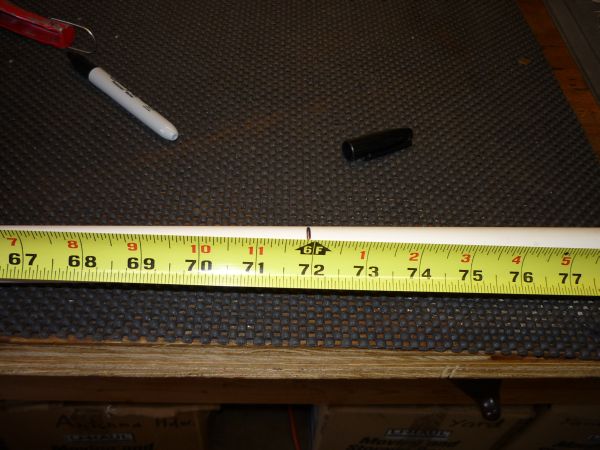
Cut 6 or 7 feet of 1″ thin-wall PVC.
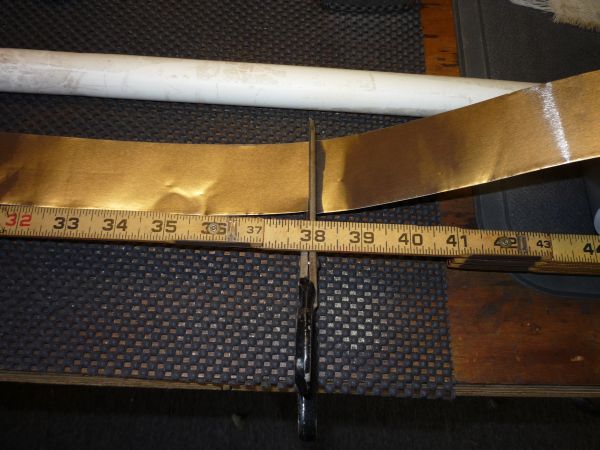
Cut two 38″ lengths of aluminum tape.
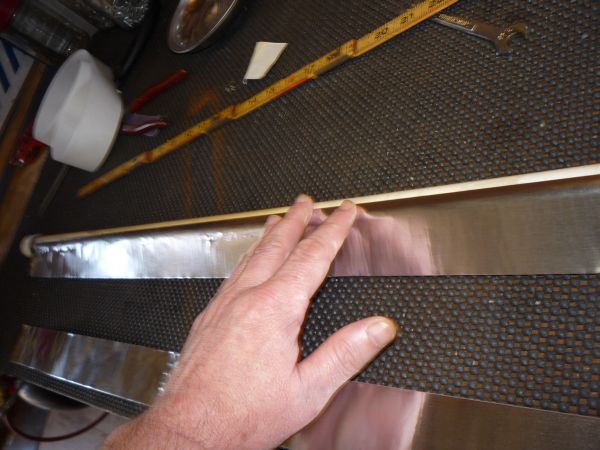
Put one edge of the first tape on the pipe, nice and straight.
Slide fingers along the tape, rotating the pipe slightly with each slide.
Try to make no wrinkles.
Apply the second tape, starting with about a 1/8th″ overlap.
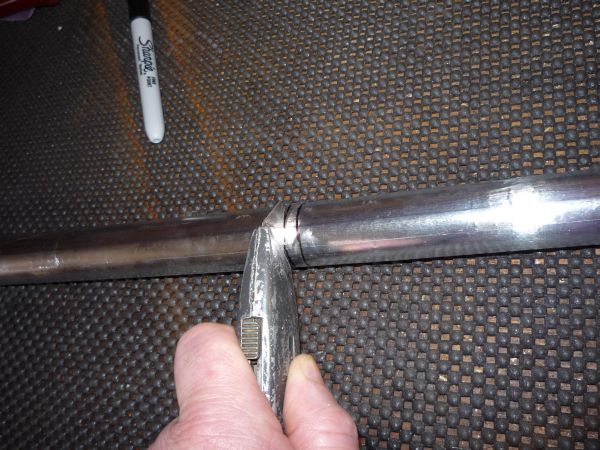
Find the exact center of the tapes and cut away ¼″.
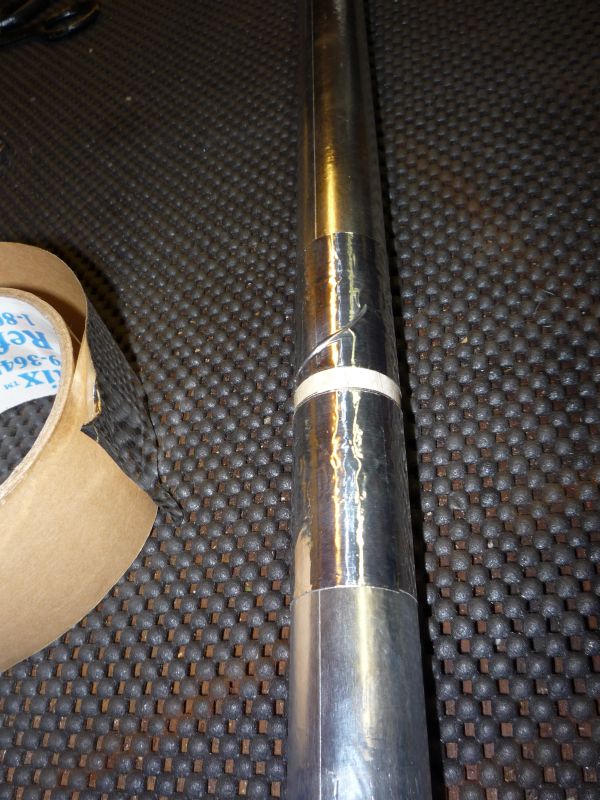
Cut 4 pieces of aluminum tape about 5 inches long. Wrap them
around the 4 ends of the two elements. The extra thickness at
the feed-point will handle more power than a single layer.
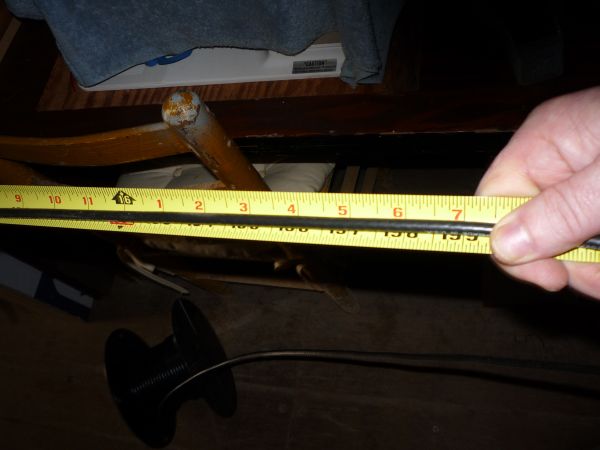
I used 16½ feet of RG-8X, which is 3 waves at 147MHz and VF .82.
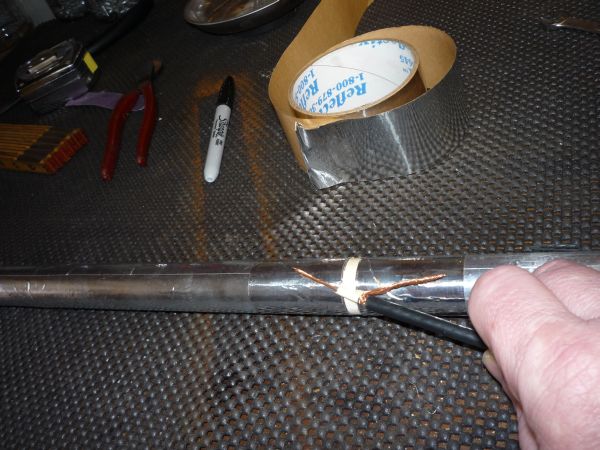
Strip out 1½ inches of the coax like this.
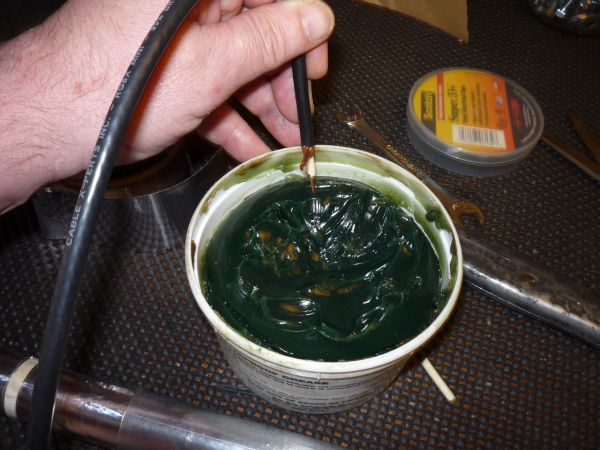
Dip the conductors in synthetic grease to help avoid corrosion.
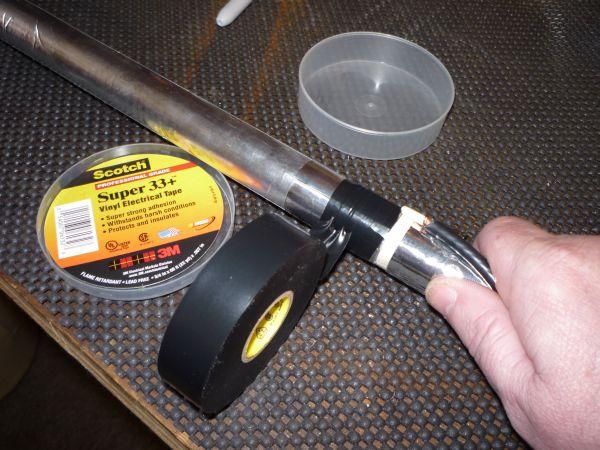
Use a high-quality tape like 33+, tightly wrap the conductors down against the pipe.
Be careful to not spread grease around while taping.
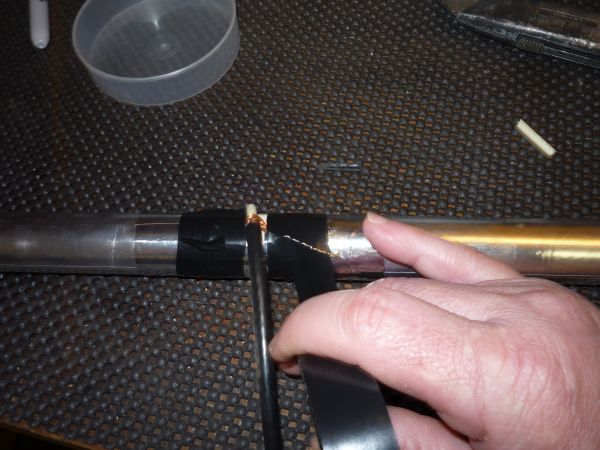
Tape down the shield, as tightly as you can stretch the tape.
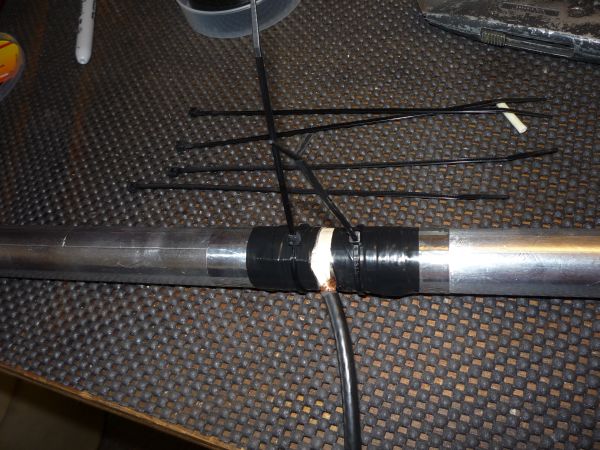
Add a couple of small ties over the taped conductors. Pull them as tight as you can
without breaking them. This is to further mash the conductors into the elements.
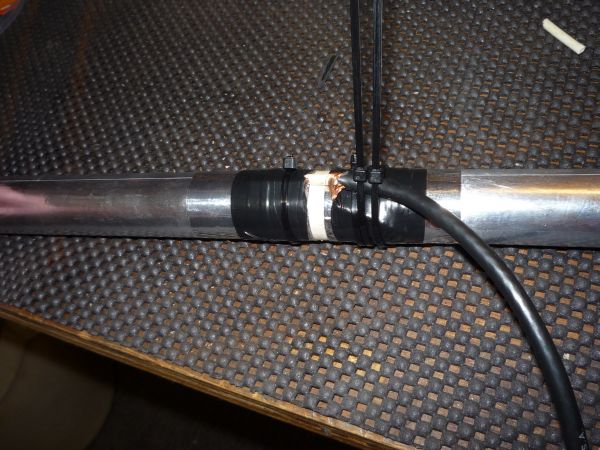
Now bring the coax down and add a couple of ties to it, as a strain-relief.
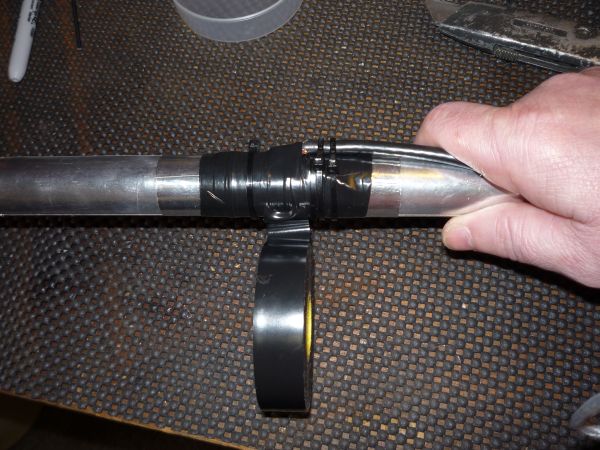
Now tape the whole connection. Start in the middle, half-lapping upwards, then
work down to the bottom, then back up to the middle. Note that you can’t do this
with cheap vinyl tape — you need something that will stretch and seal.
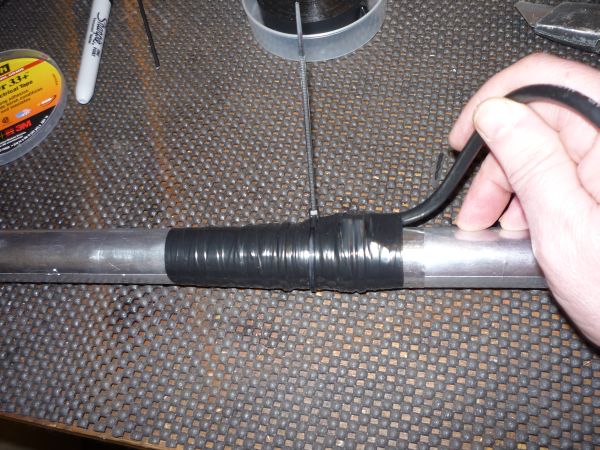
Apply a tie-wrap to the tape’s tail, so it won’t unravel.
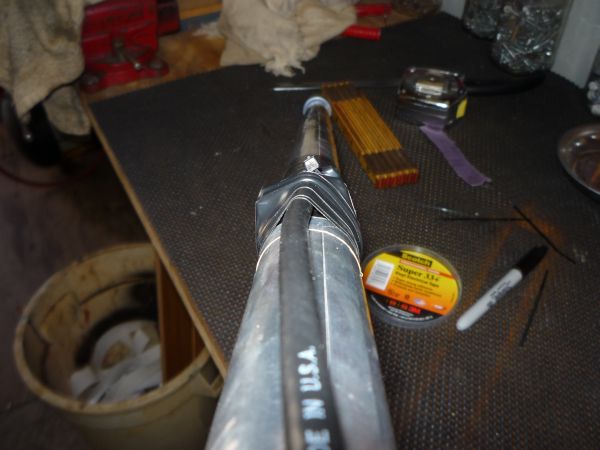
Now notice that you have these two little gaps, where the coax comes out.
Dab a little silicone caulk there to keep out spiders and moisture.
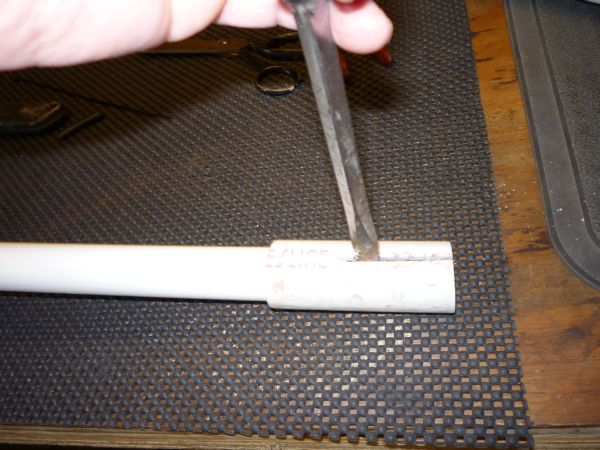
Thinwall PVC is too brittle to clamp it with a u-bolt. Cut a little piece of
sch-40, slit it, spread it, and slip it over the pipe for reinforcement.
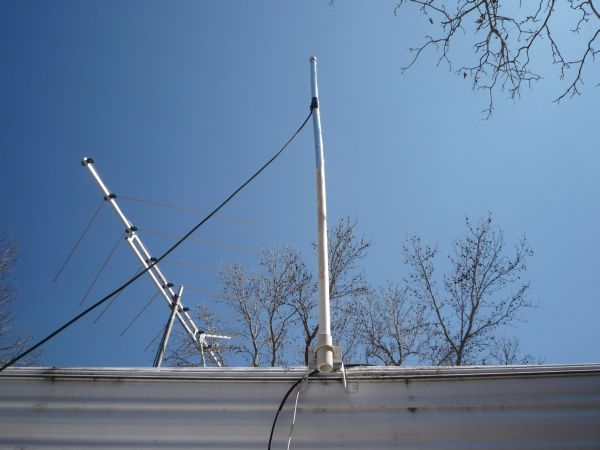
Mount it on something…
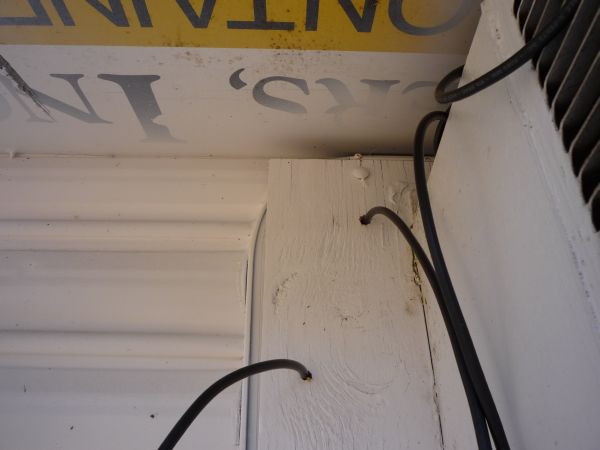
Run the coax in…
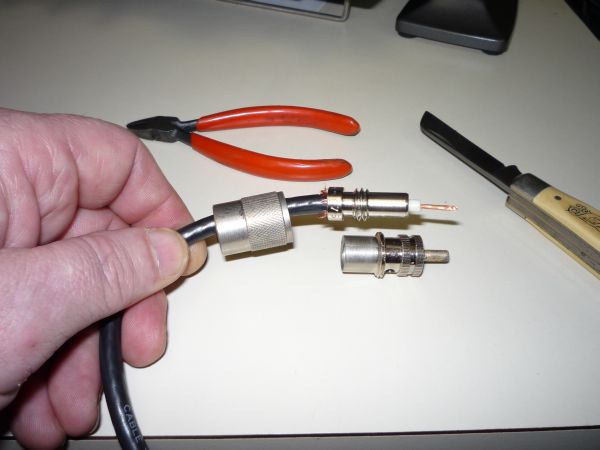
Install your favorite coax connector…
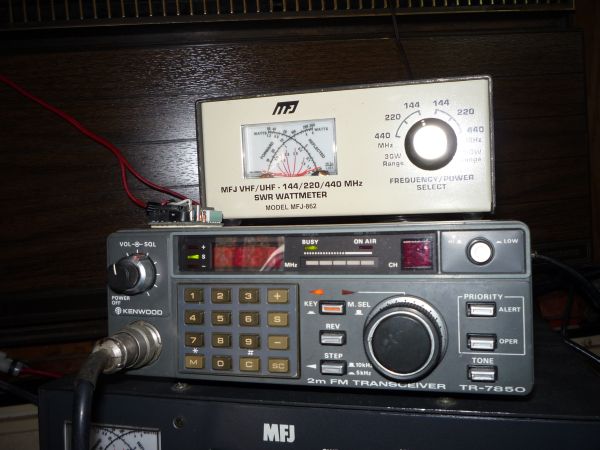
and test it!
Notes
- You can protect the elements from corrosion with paint, or better, outdoor polyurethane varnish.
- If installing near a metal roof like I did, you’ll need to find the right height above the metal before the SWR will come down. In my case, I ended up with it about ½-wave above the roof, then the SWR went nearly flat across the band. With it lower, as shown above, the SWR was around 2.
- For the elements, 38 inches (total, including the gap) should give you a low SWR across the band. If it doesn’t, try changing the antenna’s environment before altering the antenna.
- You can also adjust the SWR somewhat by changing the dangle-angle of the coax. In my case, it ended up being best about 1" from the lower element, while bringing it out perpendicular didn’t work worth a darn! That’s a lucky thing, I guess, since a perpendicular feed-line would side-load the PVC.
- If you wanna put it up on a metal pole, I’d suggest leaving ½-wave (about 40") of bare PVC between the lower element and the metal pole.
- Please feel free to drop me an email if you build one and let me know how it works or how it could be better!
So there you have it—I told you it was easy!
—73, KV5R

I like the idea of this antenna. I wonder if kitchen aluminum foil would work for the elements wrapped around a wooden rod would as well.
Do you have this same type antenna for use in the 70cm band?
It should work 70cm on the 3rd harmonic, as a 3/2-wave dipole.
I’m new to radio. I am wondering if you have to ground the antenna to earth or not.
It depends on the antenna. Symmetrical antennas like dipoles and loops are not grounded. Asymmetric antennas like end-fed long-wires, verticals, mobiles, etc, must have one grounded side to function. All metallic supports such as towers and masts must be directly grounded (with a ground rod at the base) for lightning protection.
Hey Harold,
I am interested in making this antenna but the mount point for the antenna is about 40ft away and I don’t think RG8X would cut it. Is it possible to use 450ohm WL as a feed line? My radio is an ICOM ID-51a so ultimately, the end point connector would need to be SMA male. Thanks! John (KM4JON)
It’s possible to use 1-inch ladder line on 2 meters but you also need a 1:1 choke balun and a tuner, both designed for VHF.
I think RG-8X would be OK at 40 feet, though the larger low-loss cable like 9913 or LMR400 would be better. However there’s 2 problems with that. (1) it’s gonna be too heavy for the antenna described on this page, and (2) it’s unwieldy to connect to an HT, so you’d need to add a short pigtail of RG-174 or RG-316, with the appropriate connectors and adapter.
73, –KV5R
I am looking to build this in the next few days to be paired with a raspberry pi w/ RTL-SDR dongle for APRS decoding/display in Xastir. As I am really only worried about using this antenna for APRS, what sort of adjustment to the length of tape would I need to make to center on the APRS freq?
If you mean 144.390, 39″ would center it around there, though the antenna is broadband enough to work well across the 2-meter band cut at 38″ as shown.
Do you think that wrapping aluminum tape over PVC pipe would work on a home brew 20 meter ground mounted vertical? I was thinking that this might increase the bandwidth as opposed to just running a wire through the PVC pole. Your thoughts?
Yes, that could work, if you guy the top with nylon strings to control the flexing of the pole and cracking of the tape. But a much better, long-lasting solution is to just buy 3-4 pieces of .058″ wall 6063 aluminum tubing. Like, 2, 1-7/8, 1-3/4-inch. Elevate the base 8+ feet and use 4 quarter-wave radials of #17 aluminum electric fence wire. Or build a 20 meter vertical dipole like this: http://kv5r.com/ham-radio/a-big-vertical-antenna-project/ .
73, –kv5r
I’m a fairly new ham and ive been out of it for about three years and I’m old. First, do you wrap one side of the pvc with with the aluminum strips and overlap 1/8inch, or both ends and over lap in the middle. I’m asking because the aluminum doesn’t look wide enough to circle the pipe and ovetlap 1/8 inch. If I get the answer, I think I could get the rest.
Well, the tape is 2″ wide, so two tapes is 4″, or 3-3/4″ with two 1/8th” overlaps. The 1″ thinwall PVC I used is about 3-3/4″ circumfrence, so two 2″ tapes will encircle it.
Hope it helps!
73, -kv5r
Is it at all possible to mount the antenna with a piece of string in a tree or would the set be to high?
Yes, you can hang it from a tree but use a long branch so it isn’t too close to the tree.
I have everything to build the antenna. I’m also in the middle of building a new radio desk. Covering it with Wilsonart antique white. And while I’m here, I have a Airborne Instruments Laboratory RF Attenuator type 137. It was given to me with the manual. Being a new Ham I’m not quite sure what to do with it. Any ideas will be greatly appreciated. Mark KG5TTE.
I couldn’t tell by the pics. You want to tape the coax wire’s internal conductor to one piece of the aluminum tape, and the wire’s metal shielding to the other aluminum tape piece? Also, why did you use the plural form for the word “conductor(s)”? I am actually building your antenna for the marine radio frequencies, resonating at 158.000. Do you happen to know the length of tape to use for this band? What I see in your pic of the roof mounting is, initially, the coax securely taped (parallel)to the PVC pole for an inch or two, and then the wire running at about a 45 degree angle from there. I don’t understand what and where is the “one inch dangle angle”. Thanks for posting an “easy to build” antenna. I will construct it next week if I don’t get a response from you by that time. I suspect I can answer my own anal retentive questions once I get started. 🙂
Yes, the center conductor is taped to the upper element and the shield to the lower. Then the whole connection is taped a couple inches to keep water out of the connections and coax.
Your length overall will be for resonance in the center of the VHF maritime band; the factor you will need to look up considering both the center frequency and length to diameter ratio of the elements — something like 457 / f(MHz) = L(feet), but I donno exactly what it is.
It’s best to bring the coax away perpendicular to the antenna for a few feet if possible.
73, –kv5r
Thanks! Very clear answers. I look forward to the project. 🙂
Would it hurt to use breeze clamps instead of all of the zip ties?
Yes you can use hose clamps but it would be very hard to seal the connection with tape over the worm gear. That’s why I used zip ties; easy to tape and seal.
IS THIS CONCEIVABLE TO DO WITH ALUMINUM TUBING, SEPARATED WITH THE WHITE COUPLING FOR BLACK PLASTIC WATERPIPE?
Yes.
Nice article – I am going to give it a try.
Thanks,
KV5R de KV5Q
i built one very similar to your specs. although instead of the coax running up the outside. i had it run through the middle of the PVC then drilled a hole just large enough for the coax to fit through in the middle of the length of the pipe. looks a bit cleaner and runs great. i have it roughly 50ft in the air near the top of my mast. i can hit everything within about 60 miles. works great! thanks for the overall idea!
Yes, I did the sleeve dipole before this one. See: Sleeve Dipole the feed needs to be offset a little to compensate for the interaction of the lower element with the coax shield.
73, —kv5r
Would it work Horizontal or does it need to be vertical?
White Stone, Va.
KM4TNF
Well, all the repeaters and mobiles and most bases on 2-meters are vertical polarization. Horizontal is only used (on 2m) for ssb/cw on the low end of the band, very little activity there (virtually none). You’ll lose a lot of signal if you run a 2 meter antenna horizontal.
On HF it doesn’t matter so much but on 2-meters it does. Stay vertical if you wanna hear repeaters and such.
73, —kv5r
I take it that the adhesive on the aluminum tape has a low enough resistance as to not cause problems.
Correct. There’s plenty of overlap for capacitive coupling. Note also that the coax wires are pressed against the metal side, not under the adhesive.
I like the simple 2 meter antenna and will build it in the next couple of week ends.
Thanks again,
Woody Gimbel, KJ4UEA
Oklahoma City, OK
Hi, I am wanting to build this antenna but don’t have 16ft of coax. Can I use less? Would it affect the antennas performance? Thanks, KE0AGO
No, as long as the SWR at the feedpoint is pretty low, the length of the coax shouldn’t matter. But you do need enough to come away perpendicular for at least a half-wave, then come down to the radio.